Stephen King is the master of writing stories that take an unassuming location like a mansion or a hotel room and twist them into an abomination that threatens to collapse on itself with you at the center. OTXO embodies this, pulling you into a world of high-octane gunplay, creeping dread, and yearning for a life and time that’s long since seen the sun set on its shores forever.
Ever since I started OTXO, I haven’t been able to put it down. It’s frustrating in many ways, but the core gameplay loop, banging experimental electronic soundtrack, and similarities to my favorite author’s works kept pulling me back in. The game was included in our April 2023 indie game spotlight, and I’m so pleased to be able to say that it does not disappoint.
Iterating on inspiration
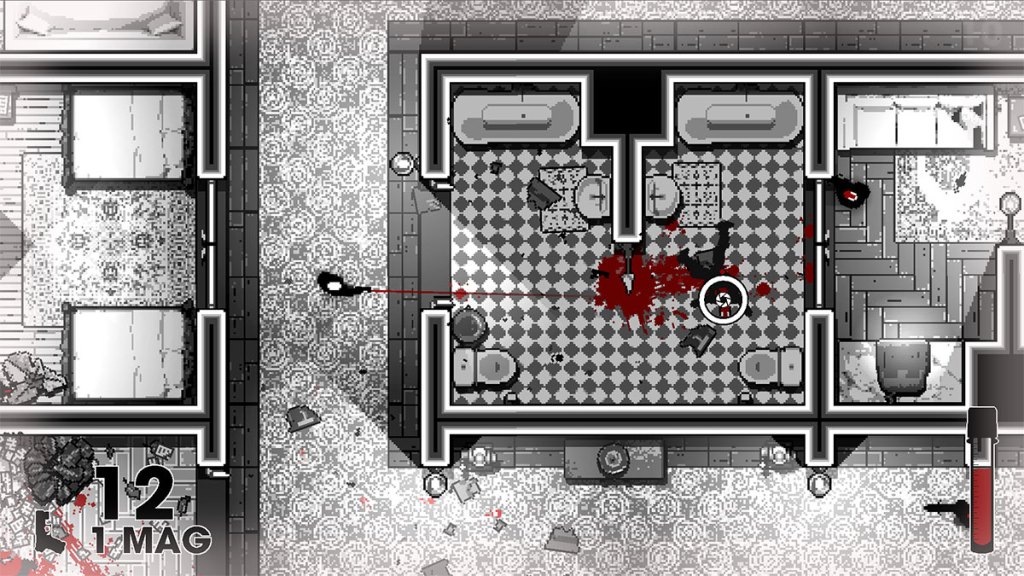
Let’s get this out of the way now: OTXO looks a lot like the Hotline Miami games. If you took that franchise and stripped out every color apart from red, black, and white, OTXO is what you’d see. That’s where the similarities end though. While very clearly visually inspired by a franchise that elevated indie games so much in the past, OTXO iterates on every other element to give you a completely different experience.
Related: The 10 best Rogue-lite games of all time
The game’s story revolves around your protagonist putting on a mask and finding themselves on a beach during an endless twilight. There’s a hotel, and if they approach, they’ll meet a questionable cast of characters who are all dripping with personality, but none of them will really tell you what’s happening. Each one knows they’re trapped, like you, and that the hotel has its own dark secrets keeping you all here. You’ve got to fight to its heart to escape, and that is far from easy.

At its core, OTXO uses twin-stick shooter mechanics within a roguelite wrapper to make every procedurally generated room, hallway, pool, and more feel unique. With each run, you’ll be kicking down doors to shoot the enemies behind them before they can shoot you. The protagonist has a health pool, so taking shots isn’t as punishing as you might expect. Still, enemies are smart and will follow loud noises and gunfire, so you’ll be quickly overwhelmed if careless.
All antagonists drop coins, which I’ll explain below, upon death, and killing multiple foes quickly will apply multipliers to help you earn more much faster. This puts an emphasis on rushing through every floor that feels suitably uncomfortable. Once I’d mastered the core mechanics, I found myself pushing to increase that multiplier more and more, and the game felt better for it.
Each run feels fresh because the layout of every floor is changed upon death. OTXO is quite unforgiving and has no problem sending you back to the very beginning if you die a few floors in. It’s enough to drive you to drink, and that’s exactly what OTXO wants you to do.
One step forward, three steps back
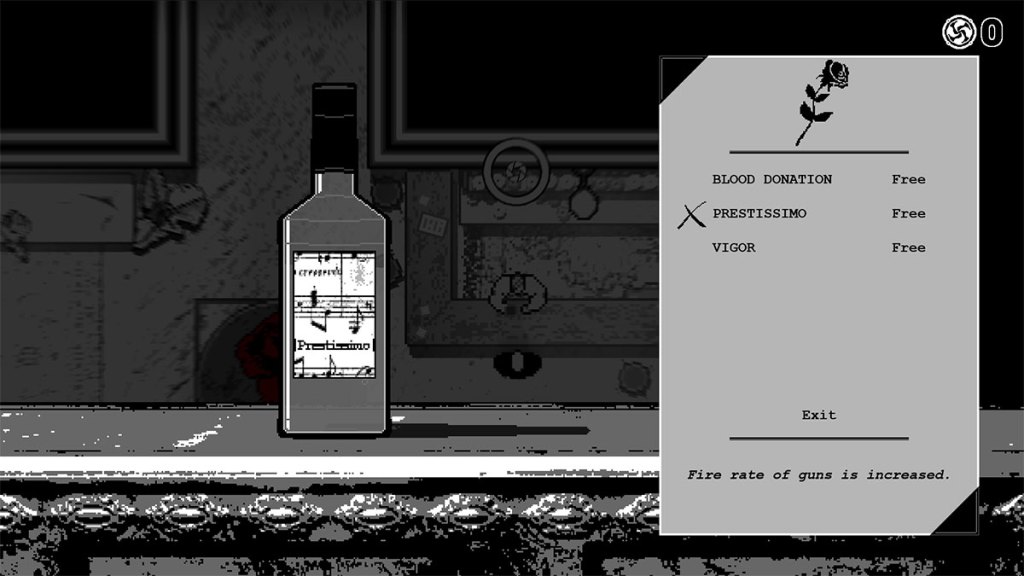
Buying drinks from the bar will apply certain effects to your character, such as being able to telekinetically pull weapons to them or producing a kunai when rolling unarmed. None of these ever felt overpowered. In fact, even with several under my belt, the hotel felt like it was winning with every step. No advantage is enough to make you feel safe, and that’s exactly how it should be in a game like this. More than anything else, these drinks make you try out different approaches to floors and bosses. The aforementioned kunai roll is fun for a stealthy approach but prevents you from earning too many coins. A power that has a chance to deflect bullets or throw some back at your foes though. Well, that makes you want to rush through every door like you’re wearing body armor.
The crux of progression outside of every run comes in the form of building up a larger roster of drinks and curiosities. I felt unstoppable when I had four or five drinks in me and was facing off against a second boss. However, just like in real life, the crushing realization of how weak I was came flooding in as this boss, despite my additional abilities, pummelled me into next Tuesday. Some drinks do work well together, but it’s more about choosing the ones that will work for your play style and the type of room you’re currently tackling. They give you a cushion of confidence that’s what you need to keep going rather than breaking the difficulty by making you some sort of twisted god-like warrior.
Coins are invested in either curiosities, which you’ll learn about from one of the beach’s NPCs, or importing new drinks. While you’re playing, you need to constantly assess whether a new drink is worth your coin or if you want to push to make this run the best one yet by purchasing a new drink and power. It slows the overall progression while adding some much-needed pacing, though it would be nice if everything linked to the bar were cheaper. I felt like I was encouraged to avoid investing in new drinks in favor of any new power, regardless of whether I’d find it helpful.

Shooting in OTXO is tight. You move with the left stick, aim with the right, and unleash a barrage of bullets with the trigger. It feels like a twin-stick shooter, especially because your character moves so fast, which can take a lot of getting used to initially. The aiming sticks where you leave the on-screen reticule, and this can catch you out when you think you’re facing an enemy, but your bullets just miss them. It’s frustrating, but it’s a skill you need to develop that feels satisfying once you’ve mastered it. After a few runs, you’ll be throwing grenades, grabbing weapons, and destroying everything in front of you in no time. A lovely touch is that the environment will be destroyed as your stray bullets and explosions land, making every floor feel like a true big-budget fight scene.
There’s a satisfying range of weapons to pick up and play with. A nice touch is that you can select which weapons are available in each run for both you and your enemies, limiting the number if you’re struggling to use or combat them. For example, I cannot make the shotguns work for me, but the enemies love to splatter me with them. By turning them off for my runs, I knew I’d have access to weapons I was better at using and understood how my enemies would move in combat because of the weapons they’d be packing.
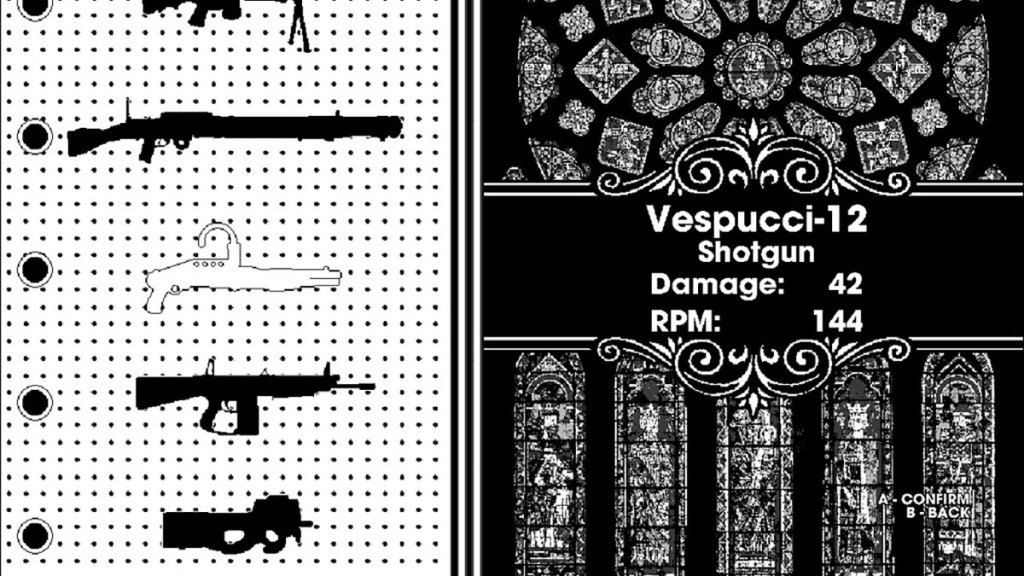
This feature also plays into the types of floor you’re tackling. Some environments, such as the bathhouse, get misty and have restricted sightlines, so long-range weapons are better. In the greenhouse, though, where enemies can see you moving through glass, short-range weapons or sniper rifles will give you an advantage over your enemies. It’s the greenhouse that taught me how to chop and change the weapons in a run and helped me learn how to move through a floor. Each one has tight corridors, but with glass, those corridors turn into massive rooms. This was frustrating at first, but that’s down to me needing to figure out how enemies saw me, not any fault from the game.
You can pick up and drop weapons at the touch of a button, but sometimes this gets confusing when guns pile up, and you can’t swap to the one you need quickly. I found myself plotting routes through floors if I wanted to, for example, use a grenade to clear a room but ensure I could retreat to a gun if it were needed.
Don’t sleep on OTXO
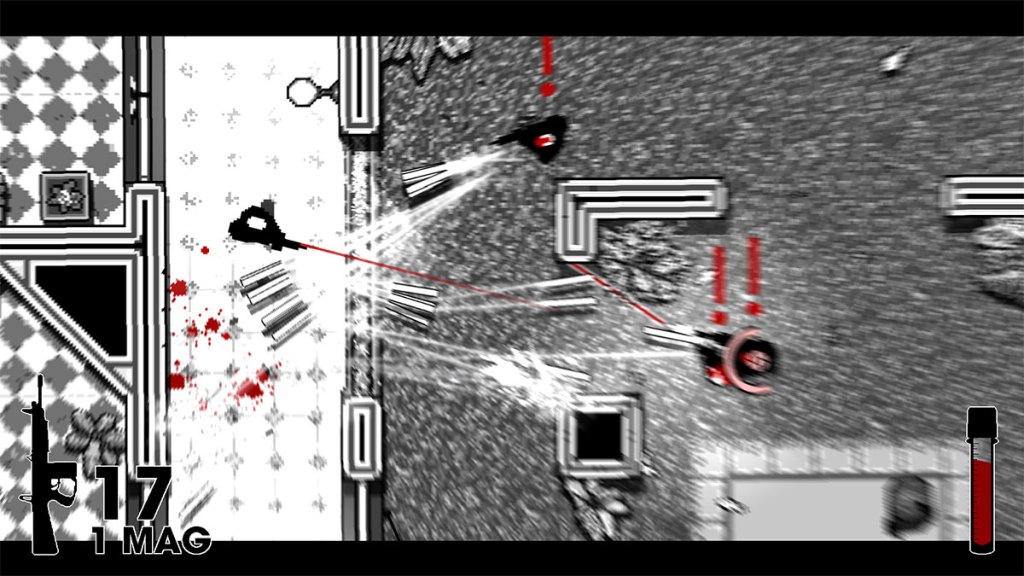
Any peace clearing a floor affords is quickly broken by the absolutely awesome soundtrack OTXO thrusts down your ears. It’s hard, fast, and has tracks to suit the environment of every floor of the hotel. These can be themed around Japanese spas, simple apartment floors, or, the one that crushed me the most, a greenhouse. It’s exactly the opposite of what you’d expect from a game with a creeping horror lurking underneath every pixel, but it works because the gameplay adds to this juxtaposition. After finishing a run, you feel that horror that’s been in the back of your mind and start to question why the protagonist is in the hotel, but once you’re shooting and listening to ear-bleeding beats, your only concern is racking up kills, coins, and multipliers. It’s as if two games have been merged here, but it works because the underlying darkness of those quieter moments never truly leaves you, it just waits for the volume to be turned down.
Between the soundtrack and the sheer variation in floor layouts, you’ll never familiarize yourself with the hotel, and that’s the point. This place is strange, occupied by strangers, and is holding you here until you’ve conquered your inner demons. You’ll uncover tidbits of story in rooms that have fallen out of one floor or another and learn more about the person you’re playing and their quest. It’s a dark tale that gets under your skin and keeps you awake at night while you wonder if the barman leaves the bar, if the sun ever sets, and why the hotel feels sentient. There’s personality everywhere, and while it might not need it to keep you engaged, it’s a fantastic bonus that there’s a world so seemingly vast in a relatively small game.
The Verdict
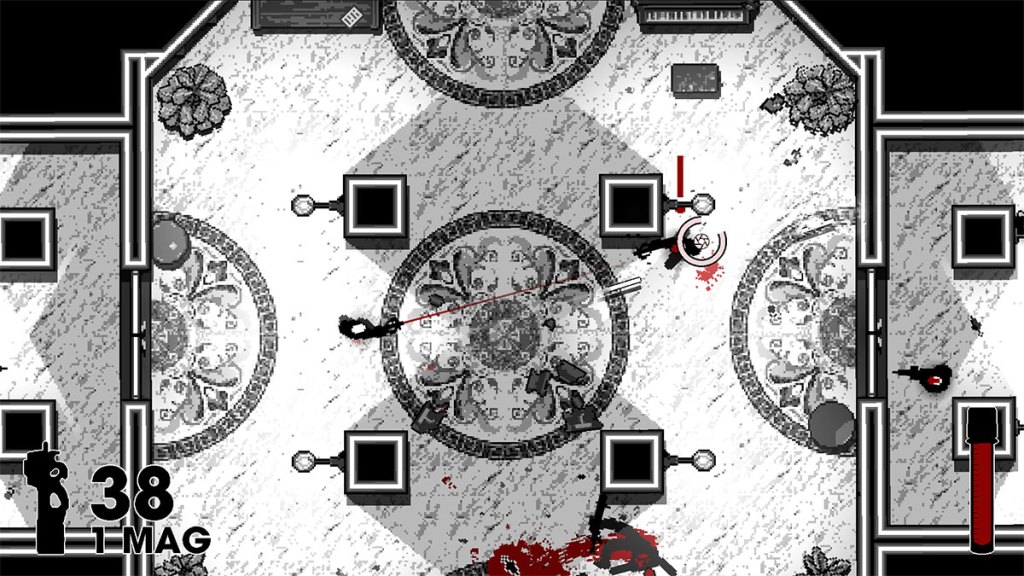
OTXO is fast-paced and endlessly replayable. Even once you’re finished with the main story, you can hop into a harder difficulty and find yourself fighting for survival all over again. The way the game contextualizes powers, weapons, and even the cycle of multiple deaths makes for a game you won’t put down quickly and will never forget. Despite it being an amalgamation of opposing genres, it epitomizes style and makes you eager to master it so you can push further in just one more run.
Final Score:
9 / 10
| + | Tight gunplay with brilliant accompanying mechanics |
| + | A story and style that sticks in your head |
| + | Satisfying gameplay loop that rewards practice and forethought |
| – | Poor inventory management when there’s a lot on screen to sift through and you’re panicking |
| – | Drinks don’t impact buildcrafting as much as I’d like |
| – | Progress felt slow-paced at times due to the price of drinks |
Gamepur team received a PC code for the purpose of this review.









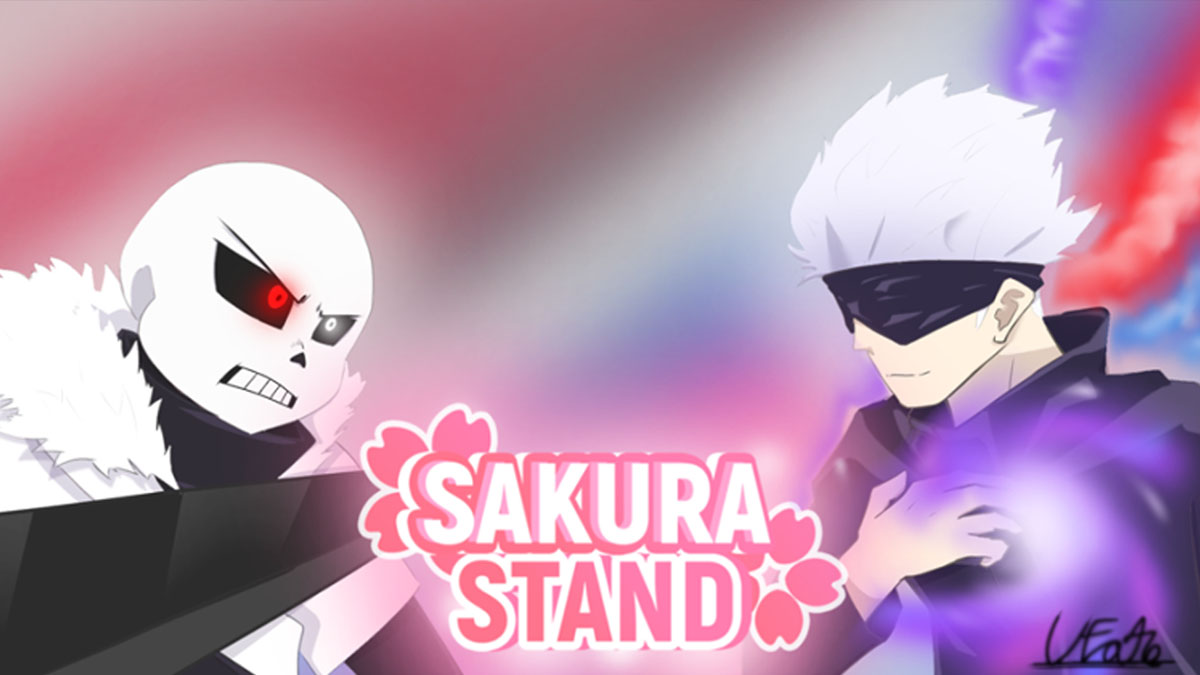
Published: Apr 19, 2023 03:14 pm